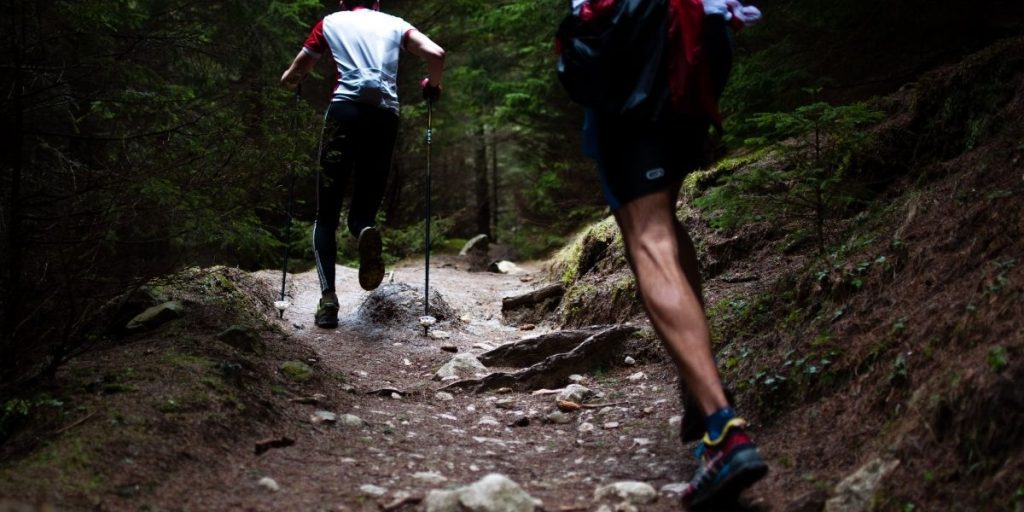![]() Hiking poles have for many years had a reputation as equipment for the elderly or infirm, but these are unfortunately completely wrong assumptions. Hiking poles, on the contrary, are aimed at the physically active who want better stability and support during hiking and trail running. We guide you in this article on how and when the rods are best used.
Hiking poles have for many years had a reputation as equipment for the elderly or infirm, but these are unfortunately completely wrong assumptions. Hiking poles, on the contrary, are aimed at the physically active who want better stability and support during hiking and trail running. We guide you in this article on how and when the rods are best used.![]()
What are walking sticks?
It is extremely important that the support and relief of the feet, ankles and knees are optimized on a long hike. These will be exposed to a lot of pressure when you move in versatile terrain with packing on your back, as the body must constantly stabilize itself. It is therefore important to wear a pair of hiking shoes or boots that match the trip to the shell. But it is not just good shoes that can help to relieve the body.
Water bars are an overlooked piece of gear that can greatly help to relieve the exposed body parts. They will give you a much better balance, which relieves the constant stabilization. And they will help you to move faster and more dynamically through challenging terrain. Many hikers and trail runners will experience an improvement in pace by exploiting the potential of a few hiking poles. In short, hiking poles are good for both increasing your metabolism, helping you in hilly terrain, reducing injuries and helping you walk longer distances. If you are curious about cool routes where you can try your hiking poles, you can read on our blog .![]()
What types of hiking poles are there?
There are many types of hiking poles, all with different characteristics and for different budgets. In general, when talking about types of hiking poles, one will typically look at three characteristics of the hiking pole: 1) What is the material that the pole is made of? 2) What level of adjustability does the rod have and 3) What type of handle does the walking rod have.
Material
There are many types of walking sticks, but common to most is that they are made of a lightweight material that makes them easier to walk with. You can typically find walking sticks in aluminum or carbon . Aluminum is a durable and economically good choice. These rods can handle a high level of stress, and can give an incredible amount without breaking. Carbon is a more expensive and lightweight choice that is good for balancing vibrations and shocks. However, these rods have a bit easier to break under a high stress level.
Adjustability
It is important to be able to adjust your hiking poles to suit both your body and the terrain you are in. Typically, hiking poles come as adjustable telescopic poles or as fixed folding poles . The advantage of the adjustable rods is that you can customize them exactly to your needs. See the next section for tips on adjusting this type of rod. It must be said that if you are looking for a very minimalist and lightweight rod, the foldable can easily be a solution for you. But we would recommend most people to buy an adjustable rod and you can find a large selection of these at our shop .
Handle
It is important that the handle helps your hand and arm with the right ergonomic support. Most hiking poles come with optimized handles that help you hold properly, but there is a difference in what material they come in. Cork is especially good in hot climates as this material is good at absorbing sweat and moisture. Foam is also sweat-absorbent, and a very soft material that is nice to hold on to. Rubber is ideal for a colder climate, as it insulates the hands from the cold, and is good for relieving shocks.

How do I set up my walking sticks?
It is important that the walking sticks fit your height and therefore it is important to check the length before you buy. When standing upright with the bar in hand, your elbow should be at a 90 degree angle when the end of the bar hits the ground. A good reminder is that if you are taller than 180 cm, you should at least buy a rod that is 130 cm, and preferably longer. If you are under 180 cm, you can adjust most of the rods down to fit you. Once you have found hiking poles that suit your height, you can experiment by adjusting the length along the way in your trip.
There is a big difference in how the bar should be adjusted depending on what terrain you are in. If you go straight into normal terrain, the hiking poles must be adjusted so that your elbow is in the 90 degrees. If, on the other hand, you go upwards, you can advantageously shorten the bars by 5-10 cm to adapt them to the body’s movement pattern. If the bars are too long here you will quickly notice that your shoulders are tense as they will be unnaturally lifted. If you go down, you can extend the rods by 5-10 cm, so you can help the body to a more upright position and better balance.
9 benefits of hiking poles
- Protects feet, ankles and knees
- Optimizes balance in uneven terrain
- Increases pace and endurance
- Improving posture
- Strengthens muscles in upper body and core
- Reduces joint strain
- Allows you to increase the distance
- Helps for effortless breathing
- Can be used as poles for tents and tarps

How do I walk with walking sticks?
It is a matter of habituation to use walking sticks, but do not throw them away after one failed attempt. We promise that the learning curve is steep in the beginning, and that you will probably quickly find the right technique for you. We have a few tips and tricks that might make it a little easier to get started.
Grip technique
It is important that your hand and wrist can relax when you use the walking sticks so that you do not go and strain the whole arm. You will quickly get tired of this and therefore they may pay to have the right grip from the start. We recommend that you use the wrist straps, as these help to relieve tension. When you put on the wrist strap, it is important that you bring your hand in from below, also pull down on the strap to grab the handle. This technique will support your wrist, and allow your hand to relax in the grip.
Gait technique
If one is to exploit the potential of the walking sticks, it is important to find the right rhythm. You walk with walking sticks by constantly lifting the opposite foot and pole. Left foot / right rod, right foot / left rod and so on. If you should get out of rhythm, you can lift the bars up and continue walking for a moment. Then put the bars down when you are ready to find your way back into the rhythm.
When you walk with walking sticks, your arms will be more elevated than they are used to. It may therefore feel unnatural to have to swing your arms as usual, but it is important to walk as naturally as possible. You can accommodate this by having the rods slightly behind you. In this way you can get a larger arm swing, and even a small start / push to get forward faster.

It takes time to turn to walking sticks, but do not give up, they can end up being a lifelong friendship.





